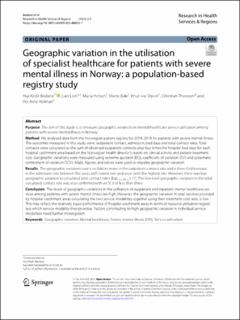| dc.contributor.author | Bedane, Haji Kedir | |
| dc.contributor.author | Lien, Lars | |
| dc.contributor.author | Holsen, Maria | |
| dc.contributor.author | Bale, Marte | |
| dc.contributor.author | Osvoll, Knut Ivar | |
| dc.contributor.author | Thoresen, Christian | |
| dc.contributor.author | Holman, Per Arne | |
| dc.date.accessioned | 2024-02-05T14:19:46Z | |
| dc.date.available | 2024-02-05T14:19:46Z | |
| dc.date.created | 2023-08-22T08:00:40Z | |
| dc.date.issued | 2023-06 | |
| dc.identifier.citation | Research in Health Services and Regions. 2023, 1-10. | en_US |
| dc.identifier.uri | https://hdl.handle.net/11250/3115674 | |
| dc.description.abstract | Purpose The aim of this study is to measure geographic variations in mental healthcare service utilisation among patients with severe mental illness in Norway. Method We analysed data from the Norwegian patient registry for 2014–2018 for patients with severe mental illness. The outcomes measured in this study were: outpatient contact, admission, bed days and total contact rates. Total contacts were calculated as the sum of observed outpatient contacts plus four times the hospital bed days for each hospital catchment area based on the Norwegian health director’s report on clinical activity and patient treatment cost. Geographic variations were measured using extreme quotient (EQ), coefficient of variation (CV) and systematic component of variation (SCV). Maps, figures, and tables were used to visualise geographic variation. Results The geographic variations saw a six-fold increase in the outpatient contact rate and a three-fold increase in the admission rate between the areas with lowest rate and areas with the highest rate. However, there was low geographic variation in calculated total contact rates (Eqs. 5 − 95 =1.77). The low-level geographic variation in the total calculated contact rate was also confirmed with an SCV of less than three. Conclusion The levels of geographic variations in the utilisation of outpatient and inpatient mental healthcare services among patients with severe mental illness are high. However, the geographic variation in total services provided by hospital catchment areas calculating the two service modalities together using their treatment cost ratio, is low. This may reflect the relatively equal performance of hospital catchment areas in terms of resource utilisation regardless which service modality they prioritise. Factors contributing to high geographic variation in individual service modalities need further investigation. | en_US |
| dc.description.abstract | Geographic variation in the utilisation of specialist healthcare for patients with severe mental illness in Norway: a population‑based registry study | en_US |
| dc.language.iso | eng | en_US |
| dc.rights | Navngivelse 4.0 Internasjonal | * |
| dc.rights.uri | http://creativecommons.org/licenses/by/4.0/deed.no | * |
| dc.subject | Geographic variation; | en_US |
| dc.subject | mental healthcare; | en_US |
| dc.subject | severe mental illness (SMI) | en_US |
| dc.subject | service utilisation | en_US |
| dc.title | Geographic variation in the utilisation of specialist healthcare for patients with severe mental illness in Norway: a population‑based registry study | en_US |
| dc.title.alternative | Geographic variation in the utilisation of specialist healthcare for patients with severe mental illness in Norway: a population‑based registry study | en_US |
| dc.type | Peer reviewed | en_US |
| dc.type | Journal article | en_US |
| dc.description.version | publishedVersion | en_US |
| dc.rights.holder | © 2023 Authors | en_US |
| dc.source.pagenumber | 10 | en_US |
| dc.source.journal | Research in Health Services and Regions | en_US |
| dc.identifier.doi | 10.1007/s43999-023-00025-7 | |
| dc.identifier.cristin | 2168585 | |
| cristin.ispublished | true | |
| cristin.fulltext | original | |
| cristin.fulltext | original | |
| cristin.qualitycode | 1 | |

